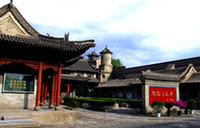'Reactionary' was highly effective governor
Unlike other warlords, Yan paid more attention to developing his hometown than to waging war, and sought a balance among different powers throughout the nearly 40 years he ruled Shanxi.
He was both friend and foe to the Communist Party of China, the Kuomintang, and even the Japanese invaders in the War of Resistance against Japanese Aggression (1937-45).
"I am dancing on three eggs. I cannot afford to break any one of them," he wrote in his diary.
He also sought a middle way in governance. Criticizing capitalism's snobbishness and communism's idealism, Yan proposed to draw lessons from both roads and develop Shanxi along the middle path, according to its practical situation.
Yan lived a simple life in Taiwan after 1949 and died of disease in 1960 at the age of 77. His Shangxi hometown fellows who went to Taiwan with him took care of his residence there and now care for his tomb.
Interestingly, local villagers in Dingxiang today, old and young, still regard Yan as the most prominent provincial governor in Shanxi.
Yan's 40-year reign saw Shanxi's fast rise from being one of the poorest provinces in China to becoming a place renowned for its affluence, education and unity.
Researchers of Yan believe his thoughts and successful governance in Shanxi offer practical models for modern-day China.





















